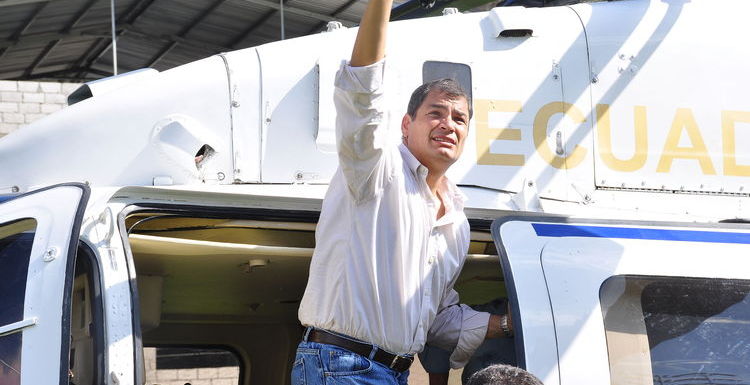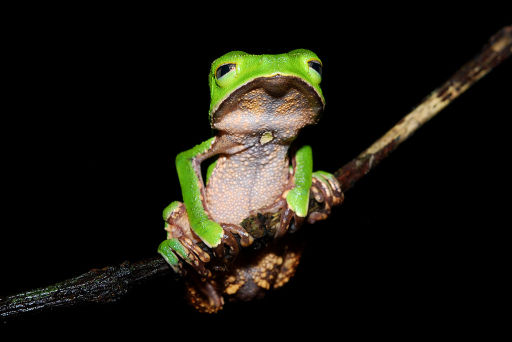Oil Drilling in Ecuador’s Yasuní National Park: Correa’s Drive Towards Development at Any Price
Abandoning his previous conservation plan, Ecuadorian President Rafael Correa announced on August 15 that he will allow oil drilling in the country’s Yasuní National Park. [1] The park, located in the pristine Amazon rainforest, holds 20 percent of the country’s total oil reserves, estimated to be worth $18 billion USD. After the discovery of oil in the Yasuní National Park in 2007, Correa announced an initiative designed to assure that oil companies that could not drill in the area. The plan, the Yasuní ITT Initiative, aimed to collect $3.6 billion USD from the international community over a period of 13 years as a payment to Ecuador for foregoing oil exploitation in the national park. This money was to be invested into Ecuador’s economy, driving growth and paying for social programs while avoiding the destructive consequences of drilling. However, the collected funds only totaled $13 million USD, a small fraction of the amount requested. In abandoning the plan, Correa expressed regret, offering that “the world has failed us.” [2]
But even if tapping into the oil riches will boost Ecuador’s economy, environmentalists, Indigenous groups, and some three-quarter of Ecuadorians in a recent poll all lament this decision, which will surely do irreparable harm to an area that is the one of the most species-diverse on earth and is also home to two of the world’s last Indigenous tribes not in contact with larger society. [3]
To some, Correa’s policy decision, an expression of what Dr. José Fuentes, a professor at the Facultad latinoamericano de ciencias sociales (Flacso) in Quito dubbed “economic pragmatism,” is understandable given Ecuador’s need for revenues to support the country’s near-tripling of public spending since 2007. [4] However, this decision represents a serious step backward for conservation efforts in Ecuador and for the Indigenous groups in the region. It exemplifies a continuing determination by Correa to prioritize economic development over the social and environmental interests of some of his key original supporters.
Correa’s Conservationist Past
In the past, Correa has positioned himself as an environmentalist and advocate for protecting the rights of the Indigenous. In his 2006 presidential bid, he was supported in the second round of elections by leftist and Indigenous parties, including Pachakutik. Throughout the campaign Correa used his ability to speak Quechua to appeal to Indigenous voters. [5] When Ecuador wrote a new constitution in 2008, Correa’s political party, Alianza País (PAIS Alliance, AP), controlled the constitutional assembly, which Correa used to control the shaping of this document. [6] The constitution, Ecuador’s twentieth, notes that “Nature, or Pacha Mama, where life is reproduced and occurs, has the right to integral respect for its existence and for the maintenance and regeneration of its life cycles, structure, functions and evolutionary processes.” [7] Ecuador’s constitution was the first in the world to give legally enforceable rights to nature. The document also provides extensive protection to Indigenous communities, affording native peoples the right to maintain ownership of their ancestral lands and to “keep and promote their practices of managing biodiversity and their natural environment.” [8] Correa’s policy turn seems to many in Ecuador to violate, if not the letter, then certainly the spirit of the Constitution. As Pachakutik delegate Carlos Pilamunga, expressed in dismay, “western development is only concerned with politics and economics… [but] we are also concerned with cultural elements, plurinationality, and the environment.” [9]
Consequences
While Correa’s decision can be justified given the state of Ecuador’s economy, the results of drilling in the Yasuní National Park will almost certainly be environmentally disastrous. While the president claims that only 1 percent of the park will be developed, environmentalists argue that the total area affected, when roads are factored in, will be 20 to 30 times larger. [10] Any environmental destruction in the area is potentially devastating for flora and fauna, as the reserve boasts “apparent world richness records for amphibians, reptiles, bats, and trees,” and several species of animals are unique to the area. [11] The recent discovery of the olinguito, a small animal in the raccoon family, in the Andean cloud forest underscores just how little is known about South American wildlife. [12] In a sense, Ecuador’s government does not know what it will be destroying.
The development also risks interfering with the lands and livelihoods of the Huaorani native people, whose reserve overlaps with the Yasuní National Park. Ecuador’s Indigenous population has a long history of hardship at the hands of those who would exploit Ecuador’s oil. Previous petroleum excavation projects resulted in widespread contamination and “massive ecological and social disruption,” leading to legal activity against U.S. oil firms for physically displacing Indigenous groups and allegedly spilling 17 billion barrels of crude oil between 1964 and 1990 in the Amazon. [13] The Tagaeri and Taromenane people, who have up to this point rejected all contact with the outside world, also could be in danger from drilling in the park. Any contact could lead to destruction for these communities.
Conclusions
At this point, it seems extremely unlikely that Correa will change his mind on drilling, meaning that the Yasuní National Park will certainly be damaged. Indigenous groups and other social movements, bolstered by the high degree of support for the conservation of Yasuní by the Ecuadorian population, could put more pressure on Correa, perhaps halting further exploration and oil extraction in environmentally sensitive zones. [14] However, Correa’s astonishing 84 percent approval ratings depend on his continued delivery of poverty reduction programs that have so helped ordinary people in Ecuador, and Correa is counting on more oil profits to pay the way.
Thomas Abbot, Research Associate at the Council on Hemispheric Affairs
Please accept this article as a free contribution from COHA, but if re-posting, please afford authorial and institutional attribution. Exclusive rights can be negotiated.
For additional news and analysis on Latin America, please go to: LatinNews.comand Rights Action
References
[1] Ecuador Approves Yasuní Park Drilling in Amazon rainforest.” BBC. August 16, 2013. Accessed August 16, 2013. http://www.bbc.co.uk/news/world-latin-america-23722204
[2] El Mundo nos ha fallado, Dice Presidente Correa al anunciar el fin de la iniciativa Yasuní ITT.” El Ciudadadano. August 15, 2013. Accessed August 21, 2013. http://www.elciudadano.gob.ec/index.php?option=com_content&view=article&id=44684:el-mundo-nos-ha-fallado-dice-presidente-correa-al-anunciar-el-fin-de-la-iniciativa-Yasuní-itt&catid=2:politica&Itemid=43
[3] Pitts, Pietro D & Nathan Gill. “Ecuador Seeks Crude in Amazon Rainforest as Economy Slows.” Bloomberg. August 16, 2013. Accessed August 16, 2013. http://www.bloomberg.com/news/2013-08-16/ecuador-plans-to-tap-crude-from-amazon-reserve-as-economy-slows.html
[4] Associated Press. “Yasuní: Ecuador Abandons plans to Stave off Amazon Drilling.” The Guardian. August 15, 2013. Accessed August 19, 2013. http://www.theguardian.com/world/2013/aug/16/ecuador-abandons-Yasuní-amazon-drilling; Ibid: Pitts & Gill, “Ecuador Seeks Crude in Amazon Rainforest as Economy Slows”
[5] “Pachakutik anunció que apoyará a Alianza País en la Segunda Vuelta.” El Universo. October 26, 2006. Accessed August 20, 2013. http://www.eluniverso.com/2006/10/26/0001/8/6E6617F2E4074F088FBDD05D9D68B767.html
[6] Becker, Marc. “Correa, Indigenous Movements, and the Writing of a New Constitution in Ecuador.” Latin American Perspectives 176 (2011): 47-62. Accessed August 20, 2013. doi:10.1177/0094582X10384209
[7] Ecuadorean Constitution. http://pdba.georgetown.edu/Constitutions/Ecuador/english08.html
[8] Ibid
[9] Ibid: Becker, “Correa, Indigenous Movements, and the Writing of a New Constitution in Ecuador.”
[10] Watts, Johnathan. “Ecuador Approves Yasuní National Park oil Drilling in Amazon Rainforest.” The Guardian, August 16, 2013. Accessed August 19, 2013. http://www.theguardian.com/world/2013/aug/16/ecuador-approves-Yasuní-amazon-oil-drilling
[11] Bass, Margot S. et al. “Global Conservation Significance of Ecuador’s Yasuní National Park.” PLoS One. January 19, 2010. doi:10.1371. Accessed August 19, 2013. http://www.plosone.org/article/info%3Adoi%2F10.1371%2Fjournal.pone.0008767
[12] Kim, Meeri. “Smithsonian Unearths a New Species of Mammal.” The Washington Post. August 15, 2013. Accessed August 19, 2013. http://www.washingtonpost.com/national/health-science/smithsonian-unearths-a-new-species-of-carnivore—the-olinguito/2013/08/15/2fb13b6c-051a-11e3-a07f-49ddc7417125_story.html
[13] Finer, Matt, et al. “Oil and Gas Projects in the Western Amazon: Threats to Wilderness, Biodiversity, and Indigenous Peoples.” PLoS One, 3(8); Dangl, Benjamin. “Dancing with Dynamite: Social Movements and States in Latin America.” AK Press, 2010.
[14] “A dos meses de su reelección Correa alcanza un 84% de popularidad.” Telam. July 26, 2013. Accessed September 16.



